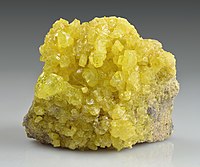
Photo from wikipedia
Abstract In the present study, we have documented hitherto unreported Ag-Pb-S, Ag-Sb-S and Sb-Ag phases associated with galena, pyrrhotite, sphalerite, freibergite, argentite, gudmundite, nisbite and breithauptite from the remobilized ore… Click to show full abstract
Abstract In the present study, we have documented hitherto unreported Ag-Pb-S, Ag-Sb-S and Sb-Ag phases associated with galena, pyrrhotite, sphalerite, freibergite, argentite, gudmundite, nisbite and breithauptite from the remobilized ore at the Sindesar Khurd base metal sulfide deposit, Rajasthan, India. These Ag-Pb-Sb-(±Cu)-S phases display pronounced compositional variability and intimate reaction relationship with coexisting sulfides and probably signify crystallization from a sulfide partial melt. To examine the possibility and nature of such melts, we have conducted evacuated silica tube experiments at 500 °C in the system Cu2S-Sb2S3-PbS-Ag2S at 10 mol % Ag2S. The melts obtained in these experiments are S-deficient, with varying concentrations of Cu (14.65–21.01 atom %), Ag (7.03–20.32 atom %), Sb (9.32–19.92 atom %), Pb (6.35–11.32 atom %) and S (44.16–48.41 atom %). The solid phases obtained are galenass, Ag-tetrahedrite and famatinite. Non-stoichiometric S-enrichment is observed in the solid phases with a complementary S-deficiency in the melt produced, in which Ag and Sb are enriched. The results of this study indicate that significant amounts of Pb-, Cu-, Sb- and Ag-enriched sulfide melts can be produced even at 500 °C and fractionation of Ag and Sb into sulfide partial melt may concentrate Ag and Sb during metamorphism of base metal sulfide deposits. The various Ag-Pb-Sb-(±Cu)-S phases observed at Sindesar Khurd perhaps are the products of late-stage crystallization and testify to the presence of sulfide partial melt.
Journal Title: Ore Geology Reviews
Year Published: 2020
Link to full text (if available)
Share on Social Media: Sign Up to like & get
recommendations!